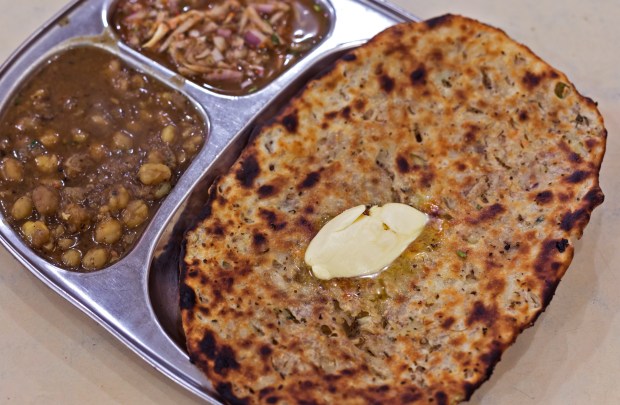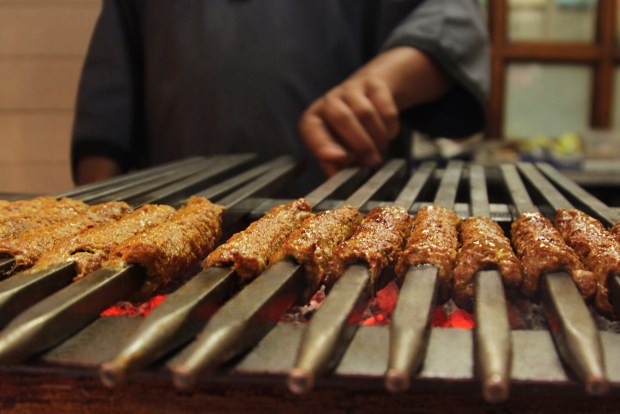“Gajā!” (bald) a family friend laughed as he rubbed the top of his arms. His brown skin was smooth and hairless. After years of working with a tandoor, the extreme heat had damaged the hair follicles. It takes years of practice to master the art of tandoori cooking—and tremendous tolerance to bear repeatedly bending over the 900°F oven.
A Punjabi tandoor is a cylindrical clay oven that is heated by a wood or charcoal fire. It is commonly used in South and Central Asia and throughout the Middle East, both to bake bread and to cook meat. The oven was popularized during the Mughal reign in India when Muslims yearned for meat in the strictly vegetarian land of the gods
In the tandoor, food is exposed to live fire convection cooking; meats are punctured on a metal skewer and placed into the heated oven; fat and juices from the meat drip on the wood or charcoal adding a distinct flavor to its smoke. In most dhabas (roadside restaurants), bread is placed along the sides of the clay oven while the meat is cooked.
Tandoori cuisine is commonly identified with Punjab. Rural villages have communal tandoors, a cost-effective way to feed large groups of people because the fire remains lit for long periods of time. The dhabas offer the best tandoori fare, and some have been serving the same recipes since the early 20th century. Punjabis resettled across India after the 1947 partition and brought their traditional tandoori cooking with them—making the tandoor essential to most local restaurants throughout the country.
What the West thinks of as Indian food is the cuisine that hails from Punjab. The buttery curries and tandoor-fired breads and meats are fixtures on menus outside of India. Here, a rough guide to the tandoor-cooked breads and meats of Punjab:
Tandoori Roti
Roti or chapati is a basic form of soft, unleavened flat bread, close to a tortilla. It is made of atta flour (whole wheat) and traditionally cooked on a tawa (round flat metal griddle). The tandoori roti, in contrast, is a crispy and slightly heavier version cooked in a tandoor that serves as a better vehicle for curry.

Naan
Naan is similar to pita and is probably the most ordered flat bread in Indian restaurants across the world. The leavened bread uses a yeast starter and is mixed with milk or yogurt to create a smooth and elastic dough. Naan takes its origins from Persia and was prepared for royals during the Mughal period in India. Due to the scarcity of yeast and complex kneading techniques the dough was primarily made in affluent households. It did not reach the streets until the 18th century. To distinguish itself from roti, naan is cooked using the high heat of a Punjabi tandoor. The clay oven cooks the naan fast and evenly, retaining its moisture. In Punjab, the chewy but soft bread is smeared with ghee before serving. It pairs well with a spicy curry, a black dal or tandoori chicken—use it to sop up gravies and juices. Keep an eye out for the non-vegetarian versions like keema naan—minced mutton.

Tandoori Chicken
The only chicken fit for the Pradhan Mantri (Prime Minister), it was fed to Jawaharlal Nehru in post-independence India. The chicken is marinated in yogurt and a special dried spice mixture. Kashmiri red chili powder gives the meat its signature bright red hue. It is then skewered and cooked on high heat inside a tandoor. The dish was invented by Kundan Lal Gujral, who owned the Moti Mahal restaurant in Peshawar, which he moved to Delhi after partition. The Moti Mahal in India’s capital still stands today. It remains a pioneer in introducing Mughal-influenced Punjabi cuisine to the rest of the world. Leftover tandoori chicken is used as the main base for the classic Punjabi “butter chicken”.
Kulcha

Wheat grows in abundance in the state of Punjab, so at most restaurants, you will find a variety of breads. The Kulcha is a regional staple that is notably eaten in both India and Pakistan. The flatbread consisting of maida (processed flour) is similar to naan in elasticity but a surprisingly softer and cheaper alternative, and incorporates baking powder and baking soda as leavening agents. The kulcha is then rolled out into a flat round shape before it is baked in an open tandoor. The famous Amritsari kulchas use less flour and are stuffed with spiced potatoes, Indian cottage cheese (paneer) or grated cauliflower. The hearty and affordable kulchas are served hot and, true to the traditions of the region, generously smothered in ghee. The kulcha- chole combination is a popular type of street food in Northern India. The kulcha is complemented by a local chickpea curry (chole or chana masala) and a tangy mint (pudina) chutney. Tear off a piece of the kulcha and dip into the fiery and flavorful dry chole. For the second bite, use the refreshing chutney to offset the spice. Vegetarian food never tasted so good.
Kebab

The kebab originated in Turkey, where freshly hunted animals were skewered on swords by soldiers and grilled on an open fire. India is an overwhelmingly vegetarian country, but a variety of meat dishes were introduced during the reign of the Mughal Empire. The influence of Mughlai cuisine can be tasted in Indian kebabs and the cooking techniques of the Muslim community in Punjab more broadly. A popular choice in Punjab is the Seekh kebab—minced lamb meat pressed onto a metal skewer—prepared similarly to most Turkish and Middle Eastern versions. But the Mughals also took a shine to Indian cooking and incorporated the local ground spices, fresh coriander and the tandoor in preparing kebabs. You may be daunted by the lengthy list of meat and vegetarian kebabs on the average dhaba menu card; do stay long enough to try them all.
Tikka
The tikka refers to a piece of meat that is marinated in yogurt and spices—similar to the savory flavors of the tandoori chicken. The dish was developed during the Mughal Empire and embodies the Muslim style of cooking in Northern India. It is cooked on metal skewers in a tandoor and served with a refreshing coriander and mint chutney. Boneless, succulent and easy to eat, tikkas are the appetizer of choice. While in Punjab, don’t stick to the average chicken tikka—the paneer (Indian cottage cheese) and macchi (fish) tikkas are a lighter option.